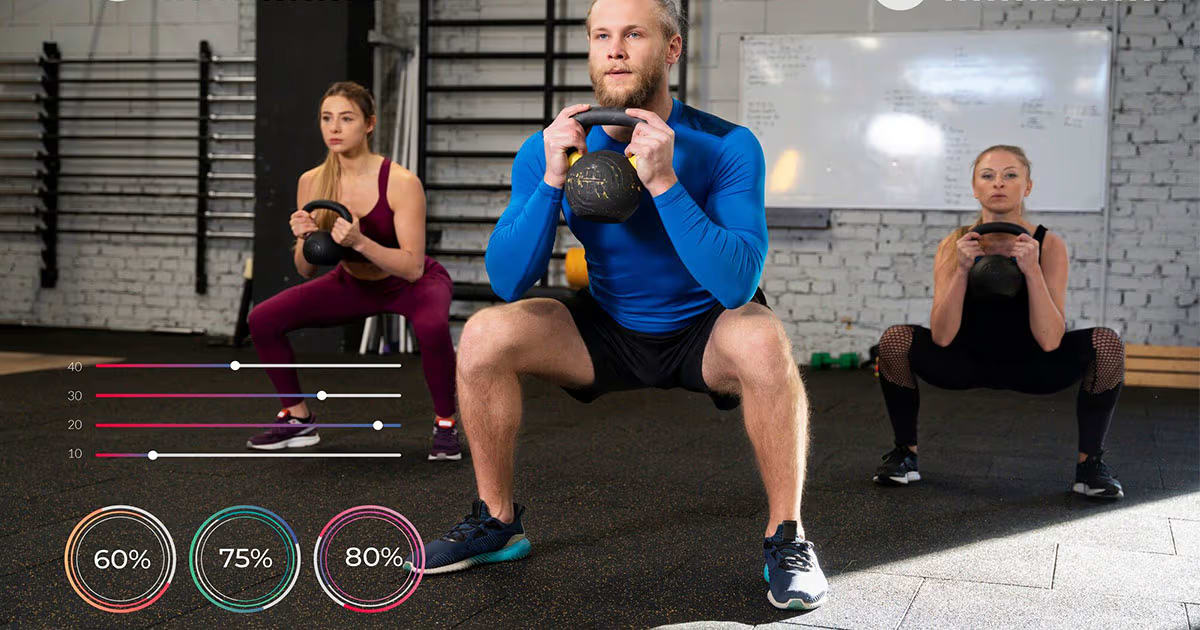
Weight training is beneficial to everyone who is at it! Whether you are a pro or a beginner, weight training should be a part of your workout plan.
Weight training is an organised exercise using weights, other devices or body weight to enhance strength, endurance, power and growth. People also call it ‘strength training’ and ‘resistance training’.
The success of a weight training session lies in four main factors, called FITT:
Before anyone starts weight training, an understanding of the muscles and how they work will be helpful.
Understanding your muscles and how they function is crucial for effective strength training. Different types of muscle contractions play a key role in exercises and their outcomes.
There are two primary types of muscle contractions:
Isometric contractions: In this type of contraction, the muscle does not change in length. A common example of an isometric contraction is pushing against a wall, where your muscles are engaged but remain stationary.
Isotonic contractions: These involve the muscle both shortening and lengthening during movement. Isotonic contractions are further divided into two phases:
Eccentric contractions are particularly notable because they are often responsible for the muscle soreness experienced after a workout, as they create more microscopic muscle damage that leads to repair and growth.
Understanding these contractions and how they apply to various exercises can help you target muscles effectively and achieve better results in your strength training routine.
Joint movements are closely linked to muscle contractions and are essential to understanding how the body moves during exercise. Among the various joint movements, four key ones to focus on are- flexion, extension, abduction, and adduction.
Flexion occurs when the angle at a joint decreases. A common example of flexion is the upward movement during an arm curl exercise. As you lift the weight, the angle in the elbow joint becomes smaller, engaging the biceps muscle.
Extension is the opposite of flexion. It involves increasing the angle at a joint. For instance, in the same arm curl exercise, as you lower the weight back down, the angle at the elbow joint increases, which is an example of extension.
Abduction refers to moving a body part away from the midline of the body in the side plane. A clear example of abduction is raising a leg out to the side of the body, such as in a lateral leg raise exercise.
Adduction is the opposite of abduction and involves bringing a body part back toward the midline of the body. For instance, after raising the leg to the side in abduction, lowering it back to the starting position is an example of adduction.
Understanding these joint movements helps in performing exercises with proper form, targeting the right muscles, and reducing the risk of injury.
The human body consists of several important muscle groups that play a key role in movement and strength training. The primary muscle groups of interest include:
Looking at these in broader terms, the major muscle groups can be simplified into:
Full-body Workouts:
Exercises like High-Intensity Interval Training (HIIT) or CrossFit-style routines work multiple muscle groups in a single session, providing an efficient way to target the entire body.
Split Training:
This involves focusing on specific areas of the body on different days, such as upper body workouts one day and lower body workouts the next. Split training is common in traditional bodybuilding programs.
Major Compound Lifts:
Movements like the squat, bench press, deadlift, clean and jerk, and snatch target large muscle groups and require multiple joints to work together, making them highly effective for building strength and muscle mass.
Understanding these muscle groups and training approaches allows for a more targeted and effective workout plan, ensuring balanced development and reducing the risk of injury.
Understanding the fundamental terms used in workouts is essential for designing an effective training program. Here’s what you need to know:
These terms form the foundation of any strength or resistance training plan, allowing you to measure progress and tailor workouts to your fitness goals. Understanding reps, sets, and RM helps ensure you’re challenging your muscles appropriately while avoiding overtraining or undertraining.
A proper diet and good nutrition are essential for getting the best results from any athletic training program, including weight training.
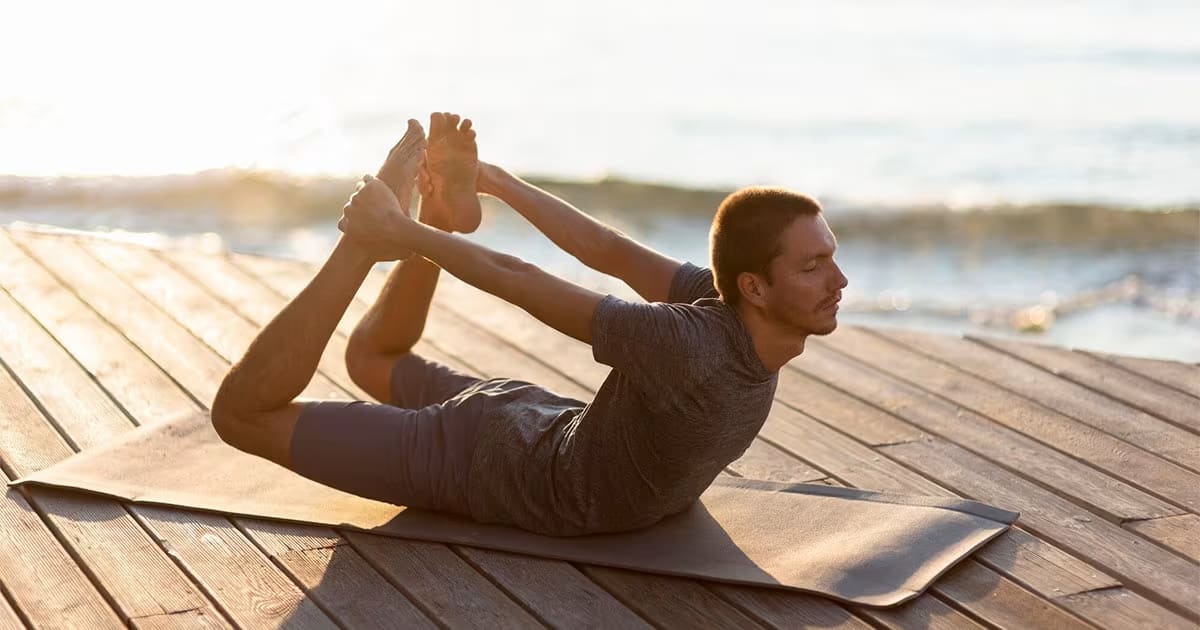
Yoga often carries an image of serene stretches on a mat, a tranquil environment, and a promise of balance. While this perception holds some truth, yoga is far more than poses or meditative breathing. It’s an ancient practice with deep roots that extend into your physical, mental, and even emotional well-being.
Yet, the true magic of yoga is how it fits seamlessly into the modern world, offering benefits that can transform your life no matter where you are or your goals.
So, let’s set aside the clichés and take an honest, fresh dive into how yoga enriches life—not just as a fitness trend, but as a holistic experience that can change how you live, work, and interact with the world.
A dumbbell is a versatile piece of fitness equipment used for strength training. It consists of a short bar with equal weights on both ends.
If you’ve ever peeked into a yoga class, you’ve probably seen people bending and stretching in almost inhuman ways. But don’t let that intimidate you. Yoga isn’t about turning into a pretzel; it’s about meeting your body where it is and working with it to create strength, mobility, and vitality.
Yoga is sometimes misunderstood as solely about stretching. In reality, many poses (asanas) are designed to build strength, particularly in your core, arms, legs, and back. Think of poses like plank, downward dog, or warrior—you’re holding your body weight while engaging multiple muscle groups.
What makes yoga unique is that this strength is built symmetrically. Unlike weight training, which often isolates specific muscles, yoga emphasizes functional strength. This means you’re improving how your muscles work together, which can prevent injuries and support other physical activities.
In today’s world, where we’re perpetually hunched over screens, poor posture has become an epidemic. Yoga gently coaxes your body back into alignment. Poses like mountain pose, cobra, and child’s pose work wonders for opening up the chest, stretching the spine, and counteracting the effects of slouching.
Over time, regular yoga practice strengthens the muscles that support good posture. A straight back doesn’t just make you look confident—it also reduces neck pain, backaches, and tension headaches.
Yoga’s low-impact nature makes it an excellent choice for those dealing with joint pain or arthritis. By gently moving your joints through their full range of motion, yoga helps lubricate them, reducing stiffness and discomfort. Additionally, weight-bearing poses like tree pose or downward-facing dog promote bone density, which is essential in preventing osteoporosis as we age.
Balance-focused poses like tree pose or eagle pose teach you how to stabilize yourself, even when the ground beneath you (literally or metaphorically) feels unsteady. This benefit is particularly valuable as you age, as it reduces the risk of falls and enhances overall coordination.
In a world that feels faster and more chaotic by the day, yoga serves as a sanctuary—a space where you can tune out the noise and tune into yourself. While the physical benefits of yoga are often discussed, its mental benefits are where many practitioners find the real treasure.
Yoga teaches you to breathe, and while that may sound basic, it’s revolutionary when done consciously. By focusing on deep, mindful breaths, you activate your parasympathetic nervous system— the “rest and digest” mode of the body. This is the opposite of the fight-or-flight response that stress triggers.
Even a few minutes in poses like a child’s pose or legs up the wall can melt away the tension that builds up during a hectic day.
Yoga isn’t just about stretching your body; it stretches your mind too. Holding poses requires concentration while syncing movements with breath fosters mindfulness. This kind of focused attention can sharpen your ability to concentrate off the mat as well, making you more present and productive in your daily life.
Yoga has been shown to increase levels of gamma-aminobutyric acid (GABA), a neurotransmitter that helps calm your brain. This makes yoga a natural remedy for those grappling with anxiety or depressive symptoms. The meditative aspects of yoga—especially slower styles like Yin or restorative yoga—allow your mind to rest and reset.
Beyond the physical and mental realms, yoga has a unique way of digging into your emotional landscape. It offers a path to self-discovery and acceptance that few other activities can match.
Through its focus on breath and mindfulness, yoga helps you develop a kind of inner stability. You learn to stay calm in the face of discomfort, whether it’s the stretch of a challenging pose or the stress of an unexpected life event. Over time, this practice translates into greater emotional resilience.
Yoga has a beautiful way of teaching you to be kind to yourself. There’s no competition on the mat, no “best” pose. The practice encourages you to honour your body’s limits on any given day and celebrate small progress. This self-compassion often spills over into other areas of life, improving your relationships with others.
Many yoga practices end with a moment of gratitude. May it be for your body, your breath, or the present moment, pausing to appreciate can transform your perspective. Gratitude, as countless studies have shown, is one of the keys to lasting happiness.
What makes yoga special is how it doesn’t treat the body, mind, and emotions as separate entities. Instead, it recognises that they’re deeply interconnected. For instance:
One of the most profound benefits of yoga is how it extends beyond the mat. Many practitioners find that the lessons they learn in yoga—patience, mindfulness, gratitude—start influencing their daily lives. They’re more patient in traffic, more mindful in conversations, and more aware of their impact on the environment.
Yoga can also inspire healthier habits. When you spend time nurturing your body and mind, you’re more likely to make choices that align with that care, whether it’s eating nutritious foods, drinking more water, or prioritizing sleep.
If you’re new to yoga, it’s easy to feel intimidated by photos of people doing handstands on Instagram or contorting into impossible shapes. But remember, yoga is a practice, not a performance. You don’t need to be flexible, strong, or experienced to start. All you need is a willingness to show up for yourself.
There are many styles of yoga, from the dynamic flow of Vinyasa to the meditative stillness of Yin. Explore what works for you, and don’t be afraid to modify poses or take breaks. The beauty of yoga is that it meets you where you are, and it’s always there to grow with you.
Yoga’s benefits are as diverse as the people who practice it. Whether you’re looking to improve your physical fitness, calm your mind, process emotions, or simply find a moment of stillness in a busy world, yoga offers something for everyone. It’s not just an exercise—it’s an invitation to reconnect with yourself and the world around you.
So, roll out a mat, take a deep breath, and step into the transformative power of yoga. Your body, mind, and soul will thank you.
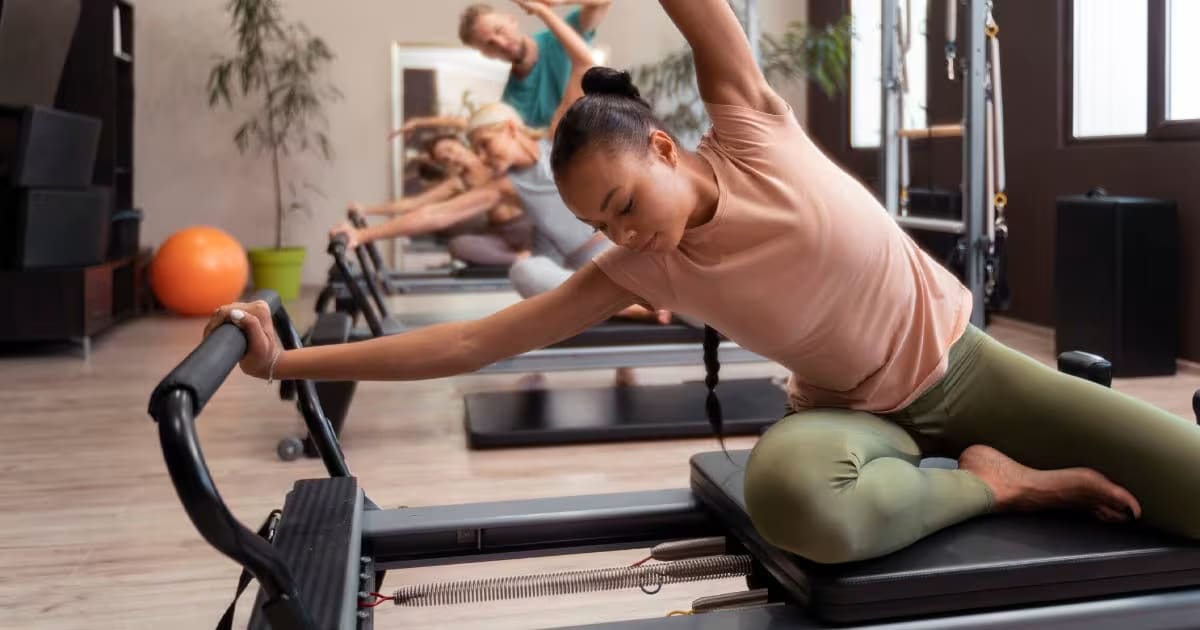
Pilates is more than just a fitness trend—it’s a transformative movement system that strengthens, stretches, and stabilises your body. But have you ever wondered, Why Pilates moves feel so effective? What’s so special about this workout? you’re not alone.
The magic of Pilates lies in its ability to blend precision, mindfulness, and science into one seamless practice. Let’s dive into the principles that make Pilates work and why it has remained a fitness favourite for decades.
Joseph Pilates developed Pilates in the early 20th century as a method of rehabilitation and strength training. Originally called “Contrology,” Pilates was designed to improve posture, core strength, and overall body awareness.
Unlike many workout programs that focus on brute force or repetitive motion, Pilates prioritises controlled movements that align the body and engage the mind.
When people talk about Pilates, they often mention the “core,” but this isn’t just about getting six-pack abs. In Pilates, the core refers to the “powerhouse,” which includes your abdominals, back muscles, pelvic floor, hips, and glutes.
Here’s why this focus on the core matters:
When you perform a Pilates move like the Hundred or a Teaser, you’re not just working your abs; you’re activating a network of muscles that work together to support your spine and limbs.
Unlike traditional workouts where you might do endless reps of the same exercise, Pilates emphasizes doing fewer movements with perfect form. This focus on precision ensures:
For example, when performing the Roll-Up, it’s not about how quickly you can sit up. Instead, it’s about controlling the movement from start to finish, engaging your core, and articulating your spine.
Pilates is famously gentle on the joints while being incredibly effective. How does this combination work?
This low-impact nature makes Pilates an excellent choice for people of all ages, including seniors and those with physical limitations.
One of the standout features of Pilates is its focus on the mind-body connection. Each move requires mental focus to coordinate breathing, alignment, and muscle engagement. This mindful approach offers several benefits:
For example, when performing the Spine Stretch Forward, the breath guides the movement, helping you connect with your body and maximize the stretch.
Pilates uniquely combines flexibility and strength in every move. Rather than bulking up specific muscle groups, Pilates creates long, lean muscles by integrating stretching and strengthening simultaneously.
This dual benefit is why Pilates enthusiasts often report feeling taller, lighter, and more aligned after a session.
Breathing is a cornerstone of Pilates, and it’s not just about inhaling and exhaling—it’s about breathing with purpose.
For instance, in the Hundred, the rhythm of your breath complements the pulsing arm movements, ensuring you stay energized throughout the exercise.
Pilates is designed to improve the way you move in real life, not just during workouts. Its focus on alignment, posture, and core strength translates to:
While mat Pilates is highly effective, equipment like the Reformer, Cadillac, or Wunda Chair adds variety and challenge. These tools use springs and pulleys to:
For example, the Reformer’s sliding carriage allows for fluid movements that challenge your core and limbs simultaneously.
Pilates isn’t just a workout—it’s a practice that delivers lasting benefits:
These results aren’t limited to the studio; the principles of Pilates can transform the way you approach movement and self-care in every aspect of your life.
Pilates works because it’s more than just exercise—it’s a mindful, science-backed system that trains your body to move smarter, not harder. By focusing on the core, precision, and mind-body connection, Pilates creates a strong foundation for fitness and wellness.
Whether you’re new to Pilates or a seasoned practitioner, its benefits will leave you feeling stronger, more balanced, and empowered.
So, why not give it a try? Unroll your mat or hop on a Reformer and experience the magic of Pilates for yourself!
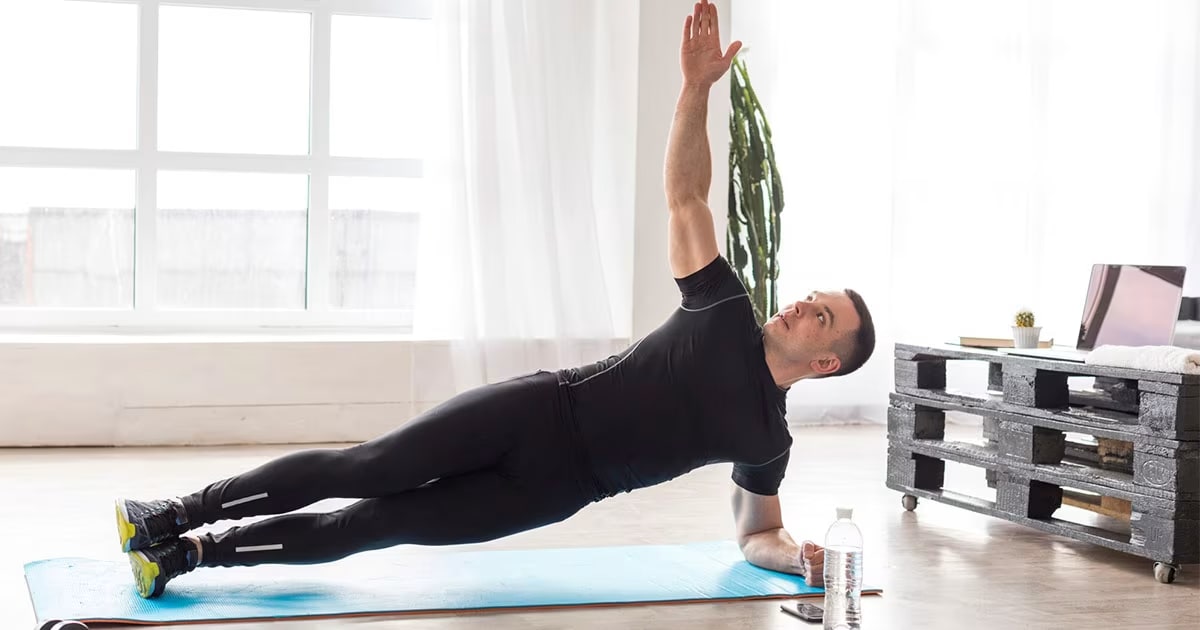
The core is more than just the abs it’s the powerhouse of your body, consisting of muscles that stabilize, support, and move your torso. Core strength is essential for good posture, balance, mobility, and overall physical performance. Whether you’re an athlete, a fitness enthusiast, or someone looking to improve daily activities, core exercises are the key to better strength and health.
In this blog, we’ll dive into the importance of a strong core, the muscles involved, and a variety of exercises to help you strengthen your core effectively. From beginners to advanced athletes, we’ll guide you through the best core exercises that are tailored to improve performance, posture, and injury prevention.
A strong core is vital for numerous reasons, both in terms of physical health and performance:
Before we jump into the exercises, it’s essential to understand the core muscles that you’ll be targeting:
Now that you know why core strength is crucial and the muscles involved, let’s dive into some of the best core exercises that target these muscles effectively. These exercises will vary in difficulty, so there’s something for everyone, from beginners to advanced athletes.
The plank is one of the most popular core exercises because it engages almost all of the muscles in your core. It is an isometric exercise, meaning you hold a position without movement, which builds strength and stability.
How to do it:
Benefits:
The dead bug is a great exercise for beginners and targets the deep core muscles, such as the transverse abdominis and pelvic floor.
How to do it:
Benefits:
The Russian twist is an excellent rotational exercise that targets the obliques and strengthens the muscles around your waist. It can be done with or without weight.
How to do it:
Benefits:
Leg raises are a powerful exercise for targeting the lower abdominals and building core stability.
How to do it:
Benefits:
Mountain climbers are a dynamic, full-body exercise that engages your core, arms, and legs. They are also excellent for cardiovascular conditioning.
How to do it:
Benefits:
The bird dog is a core stabilization exercise that targets the lower back, glutes, and abs, improving balance and coordination.
How to do it:
Benefits:
The side plank is a great way to target the obliques and strengthen the muscles on the side of the torso, improving stability and posture.
How to do it:
Benefits:
Cable woodchops are an advanced exercise that engages the core and works the rotational movement of the torso. This exercise is great for athletes who require powerful rotational strength.
How to do it:
Benefits:
1. Stability Ball
Use: Enhances balance and engages deep core muscles during exercises like crunches, planks, and bridges.
2. Medicine Ball
Use: Adds resistance for core exercises like twists, slams, and sit-ups to build strength and rotational stability.
3. Resistance Bands
Use: Provides adjustable resistance for anti-rotation exercises and oblique strengthening.
4. Ab Wheel / Roller
Use: Strengthens the entire core, including abs, obliques, and lower back, with controlled rolling motions.
5. Pilates Reformer
Use: Offers low-impact, controlled movements targeting deep core muscles while improving posture and stability.
6. Kettlebell
Use: Weighted exercises like swings and Russian twists enhance core strength and functional stability.
7. BOSU / Balance Trainer
Use: Performs planks, push-ups, and squats on an unstable surface to challenge core engagement and balance.
Core strength is essential for overall health, performance, and injury prevention. Incorporating a variety of core exercises into your fitness routine can help improve posture, stability, and power. From simple movements like planks and dead bugs to more advanced exercises like cable woodchops, there are plenty of ways to strengthen your core, no matter your fitness level.
Remember, building a strong core takes time and consistency, so be patient and stay committed. By incorporating these better core exercises into your routine, you’ll not only improve your athletic performance but also enhance your daily function and reduce the risk of injury.
Start strengthening your core today, and feel the difference in everything you do!
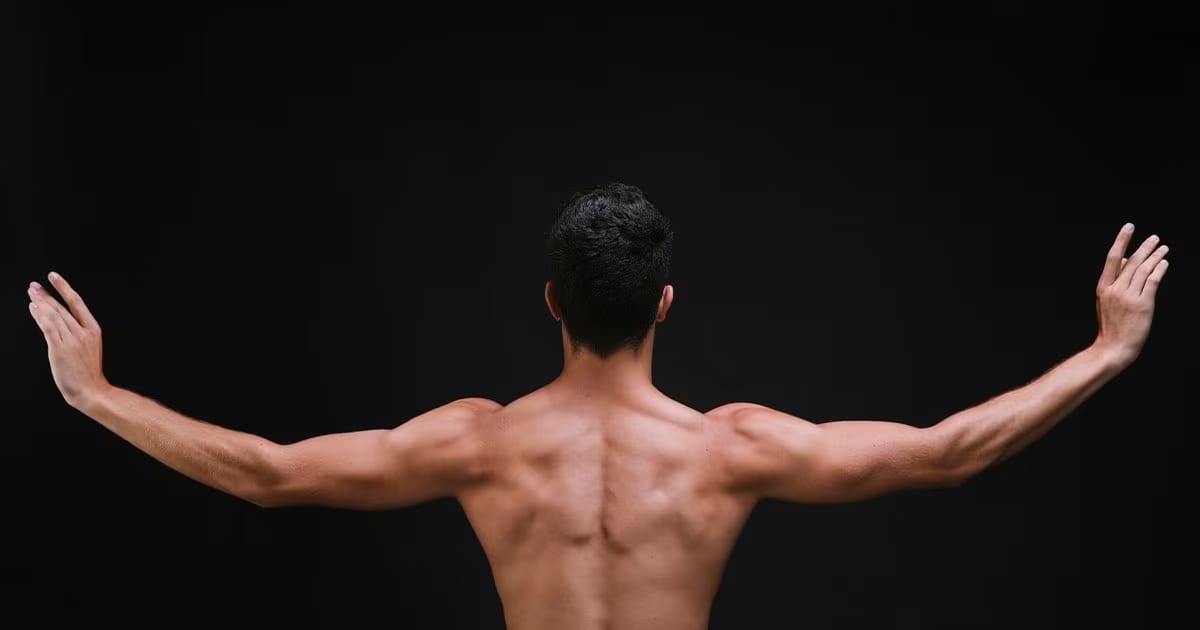
When it comes to fitness, focusing on your upper body is essential for building strength, improving posture, and enhancing overall functionality. A strong upper body not only helps you perform daily tasks with ease but also boosts athletic performance and reduces the risk of injuries. From chest and shoulders to arms and back, upper body exercises can transform your fitness journey.
This guide will cover effective upper body exercises, the best equipment to use, and tips for maximizing your workouts. Whether you’re a beginner or a seasoned fitness enthusiast, you’ll find actionable advice to help you achieve your goals.
Strengthening your upper body offers numerous advantages, including:
Before diving into exercises, it’s essential to understand the main muscle groups in your upper body:
To maximize your upper body workouts, consider incorporating the following equipment:
Warm-Up (10 Minutes):
Workout (45 Minutes):
Cool Down (5-10 Minutes):
Upper body workouts are essential for building strength, improving posture, and achieving a well-rounded physique. Whether you’re at home with minimal equipment or in the gym with access to advanced machines, there are countless ways to target your upper body effectively.
Remember, consistency is key. By incorporating these exercises and using the right equipment, you’ll be well on your way to stronger arms, a broader chest, and a more defined upper body. Keep challenging yourself, track your progress, and enjoy the journey to a fitter, healthier you!
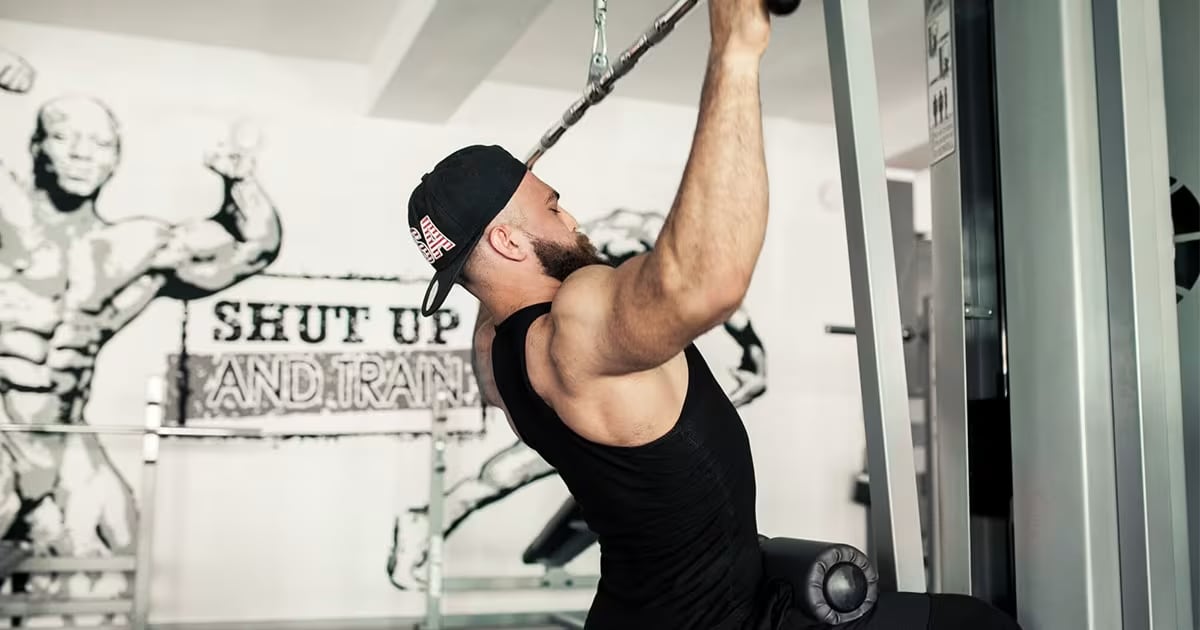
Your latissimus dorsi muscles, commonly referred to as your lats, are the largest muscles in your back. They play a crucial role in various everyday activities, such as lifting, carrying, and even breathing. Working out your lats can have numerous benefits, including improved posture, increased strength, and enhanced athletic performance.
Your lats are responsible for extending, rotating, and adducting your shoulder joint. They also stabilise your spine and maintain good posture. Weak or underdeveloped lats can lead to poor posture, back pain, and decreased athletic performance.
Several types of lat workouts can help you build stronger, more defined lats. These include:
1. Pull-ups: Pull-ups are a classic lat exercise that involves hanging from a bar and pulling yourself up until your chin clears the bar.
2. Lat Pulldowns: Lat pulldowns involve using a machine to pull a bar down towards your chest, targeting your lats.
3. Dumbbell Rows: Dumbbell rows involve holding a dumbbell in each hand and lifting them up to your sides, targeting your lats and other back muscles.
4. Seated Cable Rows: Seated cable rows involve sitting at a cable machine and pulling the cable towards your chest, targeting your lats.
Working out your lats can have numerous benefits, including:
1. Improved Posture: Stronger lats can help pull your shoulders back, improving your overall posture and reducing the risk of back pain.
2. Increased Strength: Developing strong lats can enhance your overall strength, making it easier to perform daily tasks and athletic activities.
3. Enhanced Athletic Performance: Strong lats are essential for many sports, including swimming, rowing, and golf.
4. Better Balance and Stability: Your lats help stabilize your body, making it easier to maintain balance and prevent injuries.
Building stronger, more defined lats requires a combination of proper nutrition, consistent training, and patience. Here are some tips to help you get started:
1. Start with Compound Exercises: Compound exercises, such as pull-ups and rows, work multiple muscle groups at once and are essential for building stronger lats.
2. Incorporate Variety: Vary your workout routine to include different types of lat exercises, such as lat pulldowns and seated cable rows.
3. Focus on Proper Form: Proper form is essential when working out your lats. Make sure to engage your core, keep your back straight, and avoid swinging or jerking the weight.
4. Train Regularly: Consistency is key to building stronger lats. Aim to train your lats 2-3 times per week, allowing for at least one day of rest in between.
5. Eat Enough Protein: Protein is essential for muscle growth and repair. Make sure to consume enough protein-rich foods, such as chicken, fish, and eggs, to support your lat-building goals.
Here is a sample lat workout routine that you can follow:
Monday (Lat Day):
1. Pull-ups: 3 sets of 8-12 reps
2. Lat Pulldowns: 3 sets of 10-15 reps
3. Dumbbell Rows: 3 sets of 10-12 reps
Thursday (Back Day):
1. Deadlifts: 3 sets of 8-10 reps
2. Bent-Over Barbell Rows: 3 sets of 8-10 reps
3. Seated Cable Rows: 3 sets of 10-12 reps
Sunday (Lat Day):
1. Pull-ups: 3 sets of 8-12 reps
2. Lat Pulldowns: 3 sets of 10-15 reps
3. Dumbbell Rows: 3 sets of 10-12 reps
Here are some additional tips and tricks to help you build stronger, more defined lats:
1. Use a full range of motion: Make sure to use a full range of motion when performing lat exercises, avoiding partial reps and focusing on proper form.
2. Engage your core: Engaging your core muscles can help stabilize your body and improve your overall posture, making it easier to perform lat exercises.
3. Focus on squeezing your lats: When performing lat exercises, focus on squeezing your lats at the top of the movement. This will help you engage your lats more effectively and build stronger, more defined muscles.
4. Use different grip positions: Using different grip positions, such as a pronated or supinated grip, can help target different areas of your lats and add variety to your workout routine.
5. Incorporate isometric exercises: Isometric exercises, such as planks and lat holds, can help improve your overall core strength and stability, making it easier to perform lat exercises.
If you're new to working out your lats, it's essential to start with exercises that are easy to learn and perform. Here are some lat exercises for beginners:
1. Lat Pulldowns: Lat pulldowns are a great exercise for targeting your lats without having to perform a pull-up.
2. Seated Cable Rows: Seated cable rows are another excellent exercise for beginners. They're easy to learn and can be modified to suit your fitness level.
3. Dumbbell Rows: Dumbbell rows are a great exercise for targeting your lats and other back muscles.
If you're an advanced lifter looking to take your lat workout to the next level, here are some tips and routines to consider:
1. Increase the Weight: If you're finding that your lat workouts are becoming too easy, it's time to increase the weight. This will challenge your muscles and help you build strength and size.
2. Change Your Grip: Changing your grip can help target different areas of your lats. For example, using a neutral grip can help target the upper lats, while using a pronated grip can help target the lower lats.
3. Incorporate Plyometrics: Plyometric exercises, such as box jumps and depth jumps, can help improve your power and explosiveness.
Like any muscle group, the lats are susceptible to injury. Here are some common lat injuries and how to prevent them:
1. Lat Strains: Lat strains are a common injury that can occur when the lat muscles are stretched or torn. To prevent lat strains, make sure to warm up properly before your workout and avoid using too much weight.
2. Back Strains: Back strains are another common injury that can occur when the back muscles are stretched or torn. To prevent back strains, make sure to maintain proper form when performing lat exercises and avoid twisting or bending.
3. Shoulder Injuries: Shoulder injuries, such as shoulder impingement and rotator cuff strains, can occur when the shoulder muscles are overused or injured. To prevent shoulder injuries, make sure to maintain proper form when performing lat exercises and avoid using too much weight.
When working out your lats, there are several common mistakes to avoid. These include:
1. Using too much weight: Using too much weight can put unnecessary strain on your joints and muscles, increasing your risk of injury.
2. Not using proper form: Not using proper form can reduce the effectiveness of your workout and increase your risk of injury.
3. Not engaging your core: Not engaging your core muscles can reduce the stability and effectiveness of your workout.
4. Not stretching: Not stretching can reduce your flexibility and increase your risk of injury.
Working out your lats is essential for building a stronger, more athletic body. By incorporating a variety of lat exercises into your workout routine, focusing on proper form, and training regularly, you can develop stronger, more defined lats that will improve your posture, increase your strength, and enhance your athletic performance.
Remember to be patient and consistent, and eat enough protein to support your muscle-building goals. With dedication and hard work, you can achieve the strong, athletic body you've always wanted.
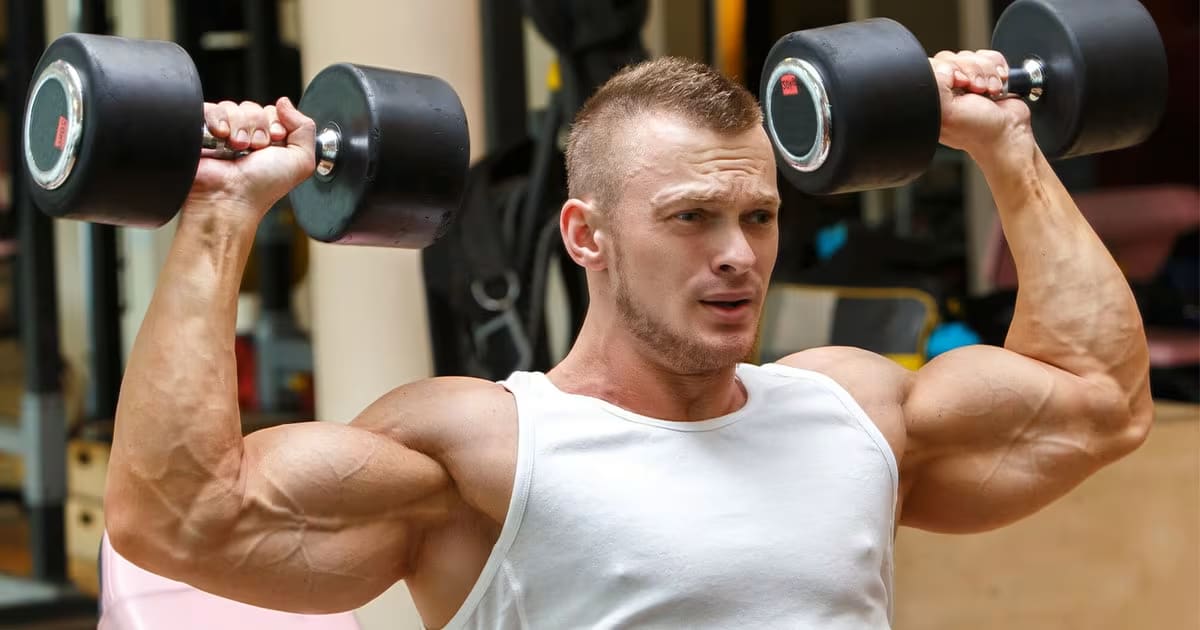
Biceps are often considered the hallmark of upper-body strength. A well-developed pair of biceps not only looks impressive but also plays a functional role in numerous daily activities and athletic movements. Whether you're lifting groceries, climbing, or showing off in a tank top, strong biceps command attention and respect.
If you're ready to grow bigger, stronger biceps, this guide is for you. We’ll dive into the anatomy of the biceps, the most effective exercises, and the equipment that can help you achieve your goals. With consistency, patience, and the right approach, you can take your biceps to the next level.
Before diving into exercises, it’s essential to understand the anatomy of the biceps. Knowing how these muscles work can help you target them effectively during your workouts.
The biceps brachii, or "biceps," are a two-headed muscle group located on the front of the upper arm. The two heads are:
These two heads work together to perform three main functions:
While the biceps are the star of this show, they don’t work in isolation. Supporting muscles like the brachialis (located underneath the biceps) and brachioradialis (in the forearm) also play a role in arm movements and overall arm aesthetics. Neglecting these muscles can result in uneven development, so a balanced approach is crucial.
Growing your biceps requires a mix of progressive overload, proper technique, and adequate recovery. It’s not just about lifting heavier weights but also about engaging the muscles effectively and consistently challenging them. Here are some foundational principles to keep in mind:
To develop bigger biceps, you need to incorporate a variety of exercises that target both heads of the biceps and their supporting muscles. Here are some of the most effective bicep-building movements:
Barbell Bicep Curl
The barbell bicep curl is a classic exercise and one of the most effective for building overall bicep size. It allows you to lift heavier weights compared to other variations, making it ideal for strength and hypertrophy.
To perform this exercise, stand upright while holding a barbell with an underhand grip. Keep your elbows close to your torso and curl the barbell upward by contracting your biceps. Slowly lower it back to the starting position.
Dumbbell Hammer Curl
The hammer curl targets not only the biceps but also the brachialis and brachioradialis, helping to add thickness to your arms. Instead of turning your palms upward, keep them facing each other throughout the movement, as if holding a hammer. This grip emphasizes the outer part of the arm.
Hold a dumbbell in each hand, palms facing inward. Curl the weights simultaneously or alternately, focusing on maintaining a controlled movement.
Incline Dumbbell Curl
Incline dumbbell curls emphasize the long head of the biceps, which contributes to the peak. By lying back on an incline bench, you stretch the biceps and isolate them more effectively.
Adjust the bench to a 45–60-degree angle, hold a dumbbell in each hand, and let your arms hang freely. Curl the weights upward while keeping your elbows stationary.
Concentration Curl
The concentration curl is a great way to isolate the biceps and eliminate momentum. It’s performed one arm at a time, allowing you to focus on squeezing the muscle.
Sit on a bench, lean slightly forward, and rest your elbow on the inside of your thigh. Curl the dumbbell upward, pausing at the top to contract the biceps before lowering it back down.
Preacher Curl
The preacher curl is another isolation exercise that prevents you from using your shoulders or back to lift the weight. This movement targets the lower part of the biceps and helps develop a fuller appearance.
Using a preacher bench, rest your upper arms on the pad and grip a barbell, dumbbell, or EZ-bar. Curl the weight upward, pause at the top, and lower it slowly.
Having the right equipment can make a big difference in your bicep training. Here’s a look at some key tools and how they can enhance your workouts:
1. Dumbbells
Dumbbells are versatile and allow for a wide range of exercises. They also let you work each arm independently, helping to correct imbalances.
2. Barbell
Barbells are ideal for lifting heavier weights, making them perfect for building strength and mass. They’re particularly useful for exercises like the barbell curl.
3. EZ-Bar
The EZ-bar, with its wavy grip, is more wrist-friendly than a straight barbell. It’s a great option for curls, especially if you experience discomfort with a standard barbell.
Resistance bands are excellent for adding variety and can be used for bicep exercises anywhere. They provide variable resistance, making the movement more challenging as you reach the top of the curl.
A preacher bench isolates the biceps, making it easier to focus on proper form and full range of motion.
Cable machines offer constant tension throughout the range of motion, which can help maximize muscle engagement. Use them for exercises like cable curls or overhead bicep curls.
Building bigger biceps isn’t just about what you do—it’s also about what you avoid. Many gym-goers unknowingly sabotage their progress by making these common mistakes:
To maximize bicep growth, you need a well-structured routine that incorporates a variety of exercises. Here’s an example of a balanced bicep workout:
Rest for 60–90 seconds between sets, and focus on maintaining proper form throughout.
Growing bigger biceps isn’t just about what you do in the gym—it’s also about how you fuel your body. Here’s what you need to know about nutrition:
Building bigger biceps takes time and effort. Don’t get discouraged if you don’t see immediate results. Stay consistent with your training, focus on proper nutrition, and allow your body the time it needs to adapt and grow. Celebrate small victories along the way, and remember that progress is a journey, not a destination.
With the right approach and mindset, bigger biceps are well within your reach. So grab those weights, commit to your goals, and watch your arms transform into a symbol of strength and determination!
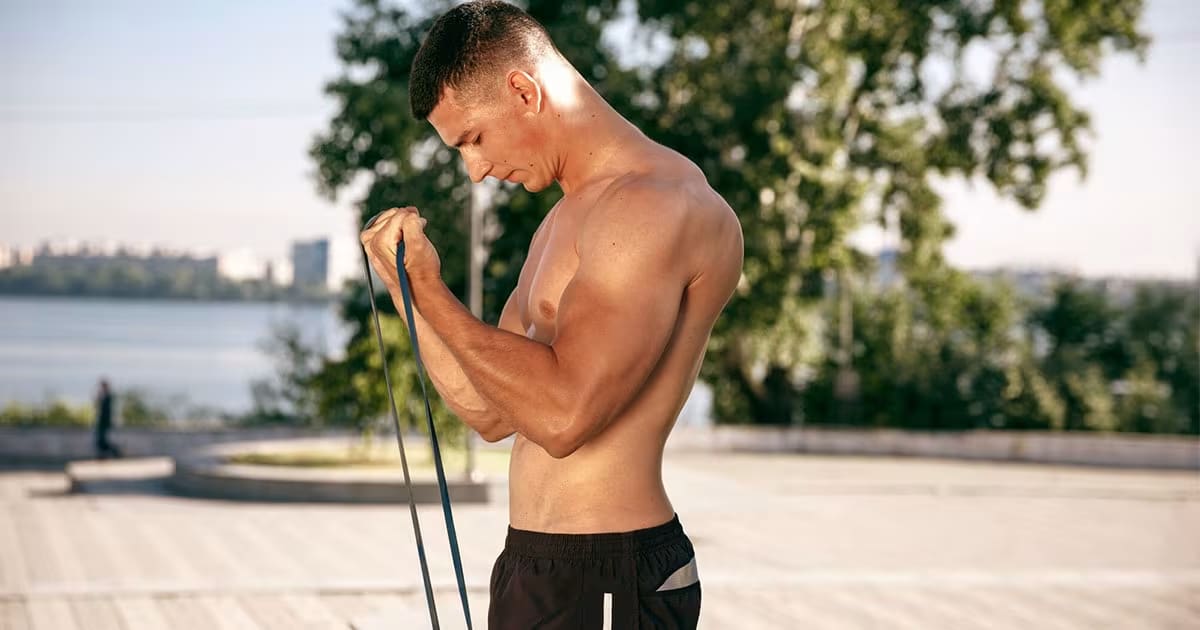
The triceps, often overshadowed by the biceps, are a vital muscle group that plays a key role in upper-body strength, aesthetics, and functionality. Whether you’re an athlete, a fitness enthusiast, or someone looking to improve their arm definition, building strong triceps is crucial.
Not only do well-developed triceps make your arms look bigger and more balanced, but they also enhance your performance in many upper-body movements like pushing, pressing, and extending.
In this blog, we’ll explore the anatomy of the triceps, discuss the best exercises for building strength, and dive into the equipment that can help you achieve your goals. With the right approach and consistent effort, you’ll be on your way to stronger, more defined triceps in no time.
Before jumping into the exercises, it’s essential to understand the anatomy of the triceps. The triceps brachii, or simply "triceps," is a three-headed muscle located at the back of the upper arm. Its primary function is elbow extension—straightening your arm from a bent position.
All three heads work together to extend the elbow, but specific exercises and angles can emphasize different parts of the triceps. Understanding this allows you to target each head effectively for balanced development.
Strong triceps are more than just a cosmetic asset. They’re involved in many everyday activities and play a critical role in upper-body movements. Whether you’re pushing a heavy door, lifting something overhead, or performing athletic actions like throwing or punching, your triceps are hard at work.
In the gym, triceps strength is crucial for exercises like bench presses, push-ups, and overhead presses. Neglecting your triceps can lead to imbalances, weaker lifts, and even a higher risk of injury. On the flip side, strengthening your triceps can improve your performance in these movements and enhance your overall upper-body power.
Now that you understand the importance of the triceps, let’s dive into the exercises that will help you build them. Effective triceps training involves a combination of compound movements and isolation exercises. Compound exercises engage multiple muscle groups, while isolation exercises target the triceps more directly.
Close-Grip Bench Press
The close-grip bench press is a compound exercise that emphasizes the triceps while also engaging the chest and shoulders. It’s a great way to build overall arm strength and size.
To perform this exercise, lie on a bench with a barbell. Grip the bar with your hands slightly narrower than shoulder-width apart. Lower the bar to your chest, keeping your elbows tucked close to your sides, and then push it back up.
Tricep Dips
Tricep dips are a bodyweight exercise that targets the triceps, shoulders, and chest. They’re highly effective and can be done with minimal equipment.
Using parallel bars or a dip station, lower your body by bending your elbows until your upper arms are parallel to the ground. Push yourself back up to the starting position, focusing on engaging your triceps.
Overhead Tricep Extension
The overhead tricep extension is an isolation exercise that primarily targets the long head of the triceps. It’s especially effective for building size and improving shoulder stability.
Hold a dumbbell or an EZ-bar with both hands and lift it overhead. Keep your elbows close to your ears as you lower the weight behind your head, then extend your arms to return to the starting position.
Cable Pushdowns
Cable pushdowns are a versatile exercise that provides constant tension throughout the movement, making them excellent for isolating the triceps. You can use different attachments, such as a straight bar, rope, or V-bar, to target the triceps from various angles.
Stand in front of a cable machine with a high pulley. Grip the attachment, keep your elbows tucked to your sides, and push the handle downward until your arms are fully extended. Slowly return to the starting position.
Skull Crushers
Skull crushers, also known as lying tricep extensions, are a staple in triceps training. They target all three heads of the triceps, with a particular emphasis on the long head.
Lie on a bench with a barbell or EZ-bar. Hold the bar with an overhand grip and lower it toward your forehead by bending your elbows. Extend your arms to return to the starting position, being careful to maintain control throughout the movement.
Diamond Push-Ups
Diamond push-ups are a bodyweight exercise that places a greater emphasis on the triceps compared to standard push-ups. They’re an excellent option for building strength and endurance.
Start in a push-up position, but place your hands close together, forming a diamond shape with your thumbs and index fingers. Lower your body until your chest almost touches your hands, then push back up.
While bodyweight exercises can be effective, incorporating equipment can take your triceps training to the next level. Here’s a look at some of the most useful tools for strengthening your triceps:
Dumbbells are versatile and allow for a wide range of motion. They’re ideal for exercises like overhead extensions, kickbacks, and skull crushers.
Barbells are great for compound movements like the close-grip bench press. They allow you to lift heavier weights, which is essential for building strength and size.
Cable machines provide constant tension, making them perfect for exercises like pushdowns, overhead extensions, and reverse-grip pushdowns.
Resistance bands are lightweight and portable, making them a convenient option for home workouts or warm-ups. They’re particularly effective for high-rep triceps exercises and improving muscle endurance.
Dip Stations
A dip station or parallel bars are essential for performing tricep dips, a bodyweight exercise that builds strength and size.
Building strong triceps requires proper technique and attention to detail. Avoid these common mistakes to maximize your progress and reduce the risk of injury:
To strengthen your triceps effectively, incorporate a mix of compound and isolation exercises into your routine. Here’s an example of a balanced triceps workout:
Perform this routine 2–3 times per week, allowing at least 48 hours of rest between sessions.
Building muscle requires proper nutrition. Protein is essential for muscle repair and growth, so include sources like chicken, fish, eggs, beans, and protein shakes in your diet. Carbohydrates provide energy for intense workouts, while healthy fats support overall recovery and hormonal health.
Stay hydrated and consider consuming a post-workout meal or shake that combines protein and carbs to kickstart the recovery process.
Building stronger triceps takes time, consistency, and dedication. Don’t get discouraged if you don’t see immediate results. Focus on improving your technique, challenging yourself with progressive overload, and giving your muscles the time they need to recover and grow.
With a well-rounded approach to training, nutrition, and recovery, you’ll be well on your way to developing powerful, defined triceps that enhance both your performance and appearance. So grab those weights, stay committed, and watch your progress unfold!
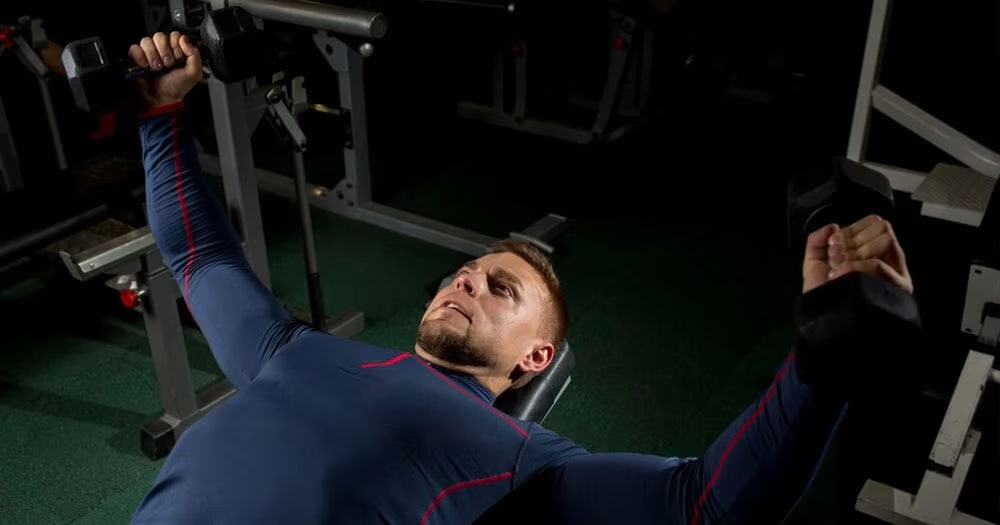
Building a strong and defined chest is a common fitness goal, and for good reason. The chest muscles, collectively known as the pectorals, play a crucial role in upper body strength and function. Whether your aim is to improve your physical performance, enhance your appearance, or simply increase overall health, focusing on chest exercises is a vital part of a balanced fitness regimen.
This guide dives deep into the best exercises for your chest, explains how to perform them correctly, and provides tips for maximizing results. With consistent effort and attention to detail, you can achieve a stronger, more sculpted chest.
Before exploring specific exercises, it’s helpful to understand the anatomy of the chest muscles. The chest is primarily composed of two main muscles:
A well-rounded chest workout targets both the upper and lower portions of the pectorals to create balance and strength.
The Importance of Warm-Up
Warming up before any workout is essential to prevent injury and prepare your body for physical activity. For chest workouts, a warm-up should include dynamic stretches and light cardio to increase blood flow to the muscles. Consider incorporating:
Choosing the Right Equipment
Chest exercises can be performed using various types of equipment or even just your body weight. Here are some common options:
The bench press is a classic and highly effective chest exercise. It primarily targets the pectoralis major while also engaging the triceps and shoulders.
How to Perform:
Variations:
2. Push-Ups
Push-ups are a simple yet effective bodyweight exercise that can be performed anywhere. They work the chest, triceps, and core.
How to Perform:
Variations:
Dumbbell flyes are excellent for isolating the chest muscles and improving flexibility.
How to Perform:
Tips:
Cable crossovers provide constant tension on the chest muscles throughout the movement.
How to Perform:
Tips:
5. Chest Dips
Chest dips are a compound exercise that targets the lower chest, triceps, and shoulders.
How to Perform:
Tips:
6. Pec Deck (Chest Fly Machine)
The pec deck machine isolates the chest muscles and is beginner-friendly.
How to Perform:
Tips:
While the primary exercises mentioned above are staples for chest training, there are additional movements that can enhance your workout:
7. Landmine Press
The landmine press is a unique movement that combines pressing and stability.
How to Perform:
Benefits:
8. Floor Press
The floor press is a variation of the bench press that limits the range of motion.
How to Perform:
Benefits:
1. Focus on Form
Proper form is crucial for preventing injuries and ensuring the targeted muscles are engaged. Avoid using momentum or overloading the weight, as these can compromise your technique.
2. Incorporate Progressive Overload
To build muscle, gradually increase the resistance or intensity of your exercises. This can be achieved by adding weight, increasing repetitions, or slowing down the tempo.
3. Balance Your Training
While chest exercises are important, neglecting other muscle groups can lead to imbalances and injuries. Incorporate back, shoulder, and core exercises into your routine for overall strength and stability.
4. Allow for Recovery
Muscles grow during rest, not during workouts. Allow at least 48 hours between chest workouts and prioritize sleep, hydration, and nutrition for optimal recovery.
5. Prioritize Mind-Muscle Connection
Focusing on the contraction of your chest muscles during each movement can enhance activation and results. Visualize your chest working as you perform each exercise.
Building a strong chest isn’t just about the exercises; nutrition and recovery play vital roles:
Documenting your workouts helps you stay motivated and identify areas for improvement. Record your sets, reps, weights, and any notes about your form or performance. Over time, you’ll see patterns and progress, which can boost your confidence and keep you on track.
Building a strong, defined chest takes time, dedication, and a well-structured approach. By incorporating a variety of exercises, focusing on proper form, and balancing your training, you can achieve impressive results. Remember that consistency is key, and progress is a gradual process. Whether you’re working out at the gym or at home, the effort you put into your chest workouts will contribute to a stronger, healthier, and more confident version of yourself.
So, lace up your training shoes, grab your weights, and start incorporating these exercises into your fitness routine. Your stronger, sculpted chest awaits!

The lower body plays a pivotal role in our daily lives. From walking and running to jumping and squatting, our legs, hips, and glutes are constantly in motion, providing the foundation for most of our physical activities. Yet, many people neglect lower-body training, either due to a lack of understanding of its importance or an overemphasis on upper-body workouts.
This blog will delve deep into the significance of the lower body, exploring its anatomy, the benefits of strengthening it, and a comprehensive guide to effective exercises that will help you build strength, endurance, and mobility.
Before diving into exercises, it’s important to understand the key muscle groups that make up the lower body. Each group serves a unique function, and together, they create a complex system that supports movement, stability, and strength.
1. Quadriceps
Located in the front of the thigh, the quadriceps are a group of four muscles (hence the "quad") responsible for extending the knee and stabilizing the leg. They are heavily involved in activities like running, jumping, and squatting.
2. Hamstrings
The hamstrings, located at the back of the thigh, are a group of three muscles that enable knee flexion and hip extension. These muscles are essential for explosive movements, such as sprinting and jumping.
3. Glutes
The gluteal muscles (gluteus maximus, medius, and minimus) form the buttocks and are among the strongest muscles in the body. They play a critical role in hip extension, abduction, and external rotation, as well as stabilizing the pelvis during movement.
4. Calves
The calf muscles, primarily the gastrocnemius and soleus, are located in the lower leg and are responsible for plantar flexion (pointing the toes downward). They are vital for activities like walking, running, and jumping.
5. Hip Flexors
These muscles, including the iliopsoas, help lift the thigh toward the torso and are crucial for maintaining proper posture and mobility.
6. Adductors and Abductors
The adductors, found on the inner thigh, are responsible for bringing the legs together, while the abductors, located on the outer hip, help move the leg away from the body. Both groups contribute to stability and balance.
A strong lower body is more than just aesthetically pleasing; it provides a plethora of functional, health, and performance-related benefits. Let’s explore some of the key reasons why you should prioritize lower-body training.
1. Improved Functional Strength
The lower body is responsible for basic functional movements like walking, climbing stairs, and standing up from a seated position. Strengthening these muscles ensures that you can perform these activities with ease, reducing the risk of injury and improving your quality of life.
2. Enhanced Athletic Performance
For athletes, lower-body strength is non-negotiable. Whether it’s sprinting, jumping, or pivoting, a strong lower body provides the power and stability needed for optimal performance. Sports like soccer, basketball, and tennis rely heavily on lower-body strength and agility.
3. Better Balance and Stability
Strong lower-body muscles help improve balance and stability by supporting the joints and maintaining proper posture. This is particularly important as we age, as it reduces the risk of falls and related injuries.
4. Increased Calorie Burn
The muscles in the lower body are some of the largest in the human body. Training these muscles requires more energy, resulting in a higher calorie burn during workouts. This makes lower-body exercises an excellent addition to weight-loss programs.
5. Prevention of Chronic Conditions
Strengthening the lower body can help alleviate or prevent chronic conditions like lower back pain, knee pain, and hip dysfunction. It also supports bone health, reducing the risk of osteoporosis.
Now that we understand the importance of lower-body strength, let’s dive into some of the most effective exercises to target these muscle groups. These exercises are suitable for all fitness levels and can be performed at home or in the gym.
Squats are often called the king of lower-body exercises—and for good reason. They target multiple muscle groups, including the quadriceps, hamstrings, glutes, and calves, while also engaging the core for stability.
How to Perform:
Variations:
Lunges are excellent for unilateral strength, balance, and coordination. They work the quadriceps, hamstrings, glutes, and calves while also engaging the core.
How to Perform:
Variations:
Deadlifts are a powerhouse exercise for the posterior chain, targeting the hamstrings, glutes, lower back, and calves. They also improve grip strength and core stability.
How to Perform:
Variations:
Step-ups mimic everyday movements like climbing stairs, making them a highly functional exercise. They target the quadriceps, hamstrings, and glutes.
How to Perform:
Variations:
Calf raises are a simple yet effective exercise for strengthening the calf muscles, which are crucial for ankle stability and explosive movements.
How to Perform:
Variations:
Hip thrusts are one of the best exercises for isolating and strengthening the glutes. They also improve hip mobility and stability.
How to Perform:
Variations:
An effective lower-body workout should include a mix of compound exercises (like squats and deadlifts) and isolation exercises (like calf raises and hip thrusts). Here’s an example of a balanced workout:
The lower body is the engine of human movement, and neglecting it in your fitness routine can lead to imbalances, weaknesses, and reduced functionality. Incorporating a variety of exercises into your routine not only builds strength and power but also enhances your overall health, athletic performance, and quality of life. So, whether you’re training for a marathon, recovering from an injury, or simply striving to stay active, give your lower body the attention it deserves—and watch as it transforms your physical and mental well-being.